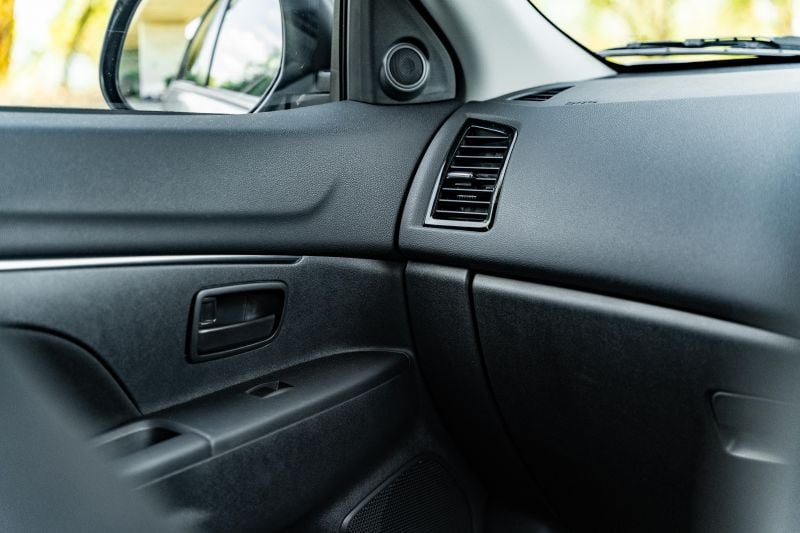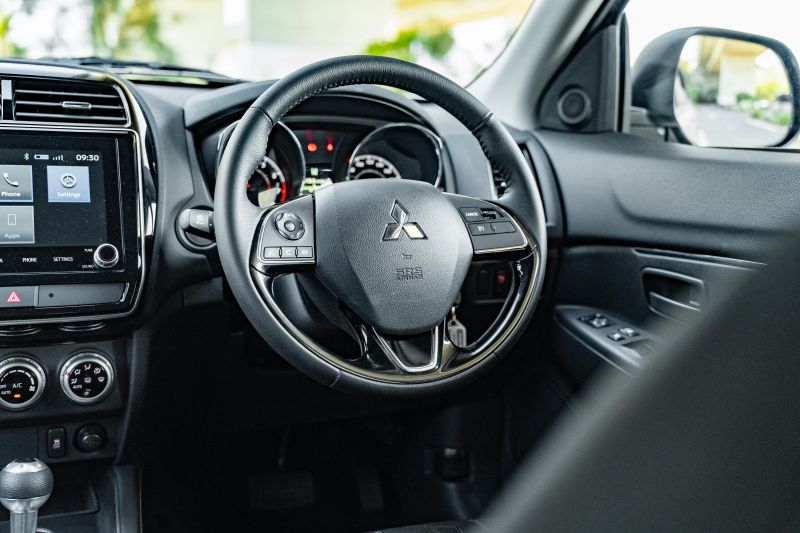But the infotainment system is actually pretty good. The 8.0-inch unit runs the latest version of Mitsubishi’s system, which is easy to use and responsive. Apple CarPlay and Android Auto are standard, as they should be.
The ES Street package brings a leather-wrapped steering wheel and gearshift, as well as a shiny black finish to the dash and door trim. It’s a bit like putting lipstick on a pig, but the additions do add a touch of class to the otherwise bland interior.
Space is good for the segment, with plenty of room in the front seats and decent headroom in the rear. The boot is a good size at 393L, but the high floor and small opening mean it’s not as practical as it could be.
The ASX isn’t perfect – far from it – but it does show that Mitsubishi has managed to add a few modern touches to an otherwise ancient interior.
What engines are available in the Mitsubishi ASX?
The ASX range kicks off with a 2.0-litre four-cylinder petrol engine making 110kW of power and 197Nm of torque. It’s available with either a five-speed manual or continuously variable transmission (CVT).
This engine isn’t particularly powerful, but it’s fine for urban driving. The CVT can be a bit noisy when you put your foot down, but it does a good job of mimicking a conventional automatic.
If you want a bit more grunt, there’s a 2.4-litre four-cylinder engine making 123kW of power and 222Nm of torque. It’s only available with a CVT, and only in the GSR and Exceed variants.
The 2.4-litre engine is a better match for the ASX, providing more effortless performance for highway driving and overtaking.
Both engines are fairly efficient, with the 2.0-litre using a claimed 7.6L/100km and the 2.4-litre using 7.9L/100km on the combined cycle.
What is the Mitsubishi ASX like to drive?
The ASX isn’t the most exciting car to drive, but it does the job. The steering is light and easy, making it a breeze to drive around town. The ride is comfortable, with the suspension soaking up most bumps well.
On the open road, the ASX can feel a bit underpowered, especially with the 2.0-litre engine. The CVT can be a bit noisy when you need to accelerate quickly, but it’s fine for cruising at highway speeds.
The 2.4-litre engine is a better match for the ASX, providing more urgency when you need it. It’s not a sporty SUV by any means, but it’s more relaxing to drive than the 2.0-litre version.
Overall, the ASX is a competent but not outstanding performer on the road.
What are the Mitsubishi ASX variants like?
The Mitsubishi ASX is available in a range of variants to suit different budgets and preferences. The entry-level ES comes well-equipped with features like a reversing camera, rear parking sensors, cruise control, and a touchscreen infotainment system with Apple CarPlay and Android Auto.
The LS adds more safety features like autonomous emergency braking and lane departure warning, as well as convenience features like keyless entry and start, climate control, and rear privacy glass.
The GSR and Exceed variants add more luxury features like leather seats, a panoramic sunroof, and a premium sound system. The GSR also gets sportier styling elements like black wheels and a body kit.
Overall, the ASX offers a good range of variants to suit different needs and preferences.
The Mitsubishi ASX is a competent and practical SUV that offers good value for money. While it may lack some of the bells and whistles of its competitors, it makes up for it with its long warranty and capped-price servicing.
However, the lack of some safety features like adaptive cruise control is disappointing in a modern SUV. Mitsubishi could have easily included this feature in the ASX to make it even more appealing to buyers.
Overall, if you’re in the market for a reliable and affordable SUV, the Mitsubishi ASX is worth considering. Just be aware of its shortcomings in terms of safety features compared to other SUVs in its class.
If you own a Mitsubishi ASX, you have the opportunity to enjoy an extended warranty of 10 years or 200,000km. However, to maintain this warranty, it is essential to service your ASX at an authorized Mitsubishi dealership. Failure to do so will result in the warranty dropping to five years and 100,000km, which can be a significant loss in terms of coverage.
Scheduled servicing for the Mitsubishi ASX is required every 12 months or 15,000km, whichever comes first. The cost of each service interval varies, with prices starting at $309 for the 12 months/15,000km service and totaling $5020 for all scheduled services up to 120 months/150,000km.
While the Mitsubishi ASX may not be the most advanced or modern vehicle in its segment, it still offers a competitive package for those looking for a reliable and affordable compact SUV. The exterior styling has held up well over the years, and the interior layout and material quality remain satisfactory. Additionally, the long warranty period and low price point make it an attractive option for budget-conscious buyers.
In terms of competition, the Mitsubishi ASX faces rivals that may offer more advanced safety features but come with a higher price tag. Chinese brands like Chery and GWM also present alternatives in terms of size and price, but some buyers may be hesitant to choose them over more established brands.
Looking ahead, Mitsubishi will need to make decisions about the future of the ASX, whether to introduce a European version or develop a new model to meet stricter safety standards. For now, the current ASX remains a solid choice for those in the market for a compact SUV.
If you are interested in purchasing a Mitsubishi ASX, you can get in touch with CarExpert’s trusted dealers for more information. Remember to adhere to the scheduled servicing requirements to maintain the extended warranty and keep your ASX in top condition for years to come. The world is full of amazing and beautiful places to explore, and one of the most captivating destinations is the ancient city of Petra in Jordan. Known as the “Rose City” for its pink sandstone cliffs, Petra is a UNESCO World Heritage site that dates back to the 4th century BC.
Located in the southwestern part of Jordan, Petra was the capital of the Nabatean kingdom and was a thriving city at the crossroads of important trade routes. The city was carved into the rock by the Nabateans, who were skilled architects and engineers. The most famous structure in Petra is the Treasury, a stunning temple that was carved into the rock face and served as a tomb for a Nabatean king.
Visitors to Petra can explore the city’s many tombs, temples, and other structures, all of which are beautifully preserved. The Siq, a narrow canyon that leads to the Treasury, is a highlight of any visit to Petra. Walking through the Siq is like stepping back in time, with the towering cliffs on either side creating a dramatic and awe-inspiring entrance to the city.
In addition to the Siq and the Treasury, visitors to Petra can also explore the Street of Facades, a row of tombs carved into the rock, and the Great Temple, one of the largest structures in the city. The Monastery, another impressive temple, is located high up in the cliffs and offers breathtaking views of the surrounding desert landscape.
For those looking to experience Petra in a unique way, there are several hiking trails that lead to lesser-known sites within the city. The Al-Khubtha trail, for example, offers stunning views of the Treasury from above, while the High Place of Sacrifice trail leads to a mountaintop altar with panoramic views of Petra.
In addition to its historical and architectural significance, Petra is also a place of natural beauty. The surrounding desert landscape is rugged and striking, with sandstone cliffs that change color throughout the day. The best time to visit Petra is in the early morning or late afternoon, when the light is soft and the colors of the rock formations are at their most vibrant.
Overall, Petra is a must-visit destination for anyone with an interest in history, archaeology, or natural beauty. The city’s unique combination of ancient ruins and stunning landscape make it a truly unforgettable place to explore. Whether you’re wandering through the Siq, marveling at the Treasury, or hiking to the Monastery, a visit to Petra is sure to be a once-in-a-lifetime experience. The future of artificial intelligence (AI) is rapidly evolving, with advancements in machine learning, deep learning, and natural language processing driving innovation in various industries. As we look towards the future, it is clear that AI will continue to play a significant role in shaping our world.
One of the key areas where AI is expected to have a major impact is in healthcare. AI-powered tools and technologies have the potential to revolutionize the way healthcare is delivered, from diagnosing diseases to personalized treatment plans. For example, AI algorithms can analyze medical images, such as X-rays and MRIs, to detect abnormalities and assist healthcare providers in making more accurate diagnoses.
In addition to improving diagnostic accuracy, AI can also help streamline administrative tasks in healthcare, such as scheduling appointments and processing insurance claims. This can help reduce the burden on healthcare providers and improve the overall patient experience.
AI is also expected to play a significant role in the automotive industry, particularly in the development of autonomous vehicles. Self-driving cars rely on AI algorithms to navigate roads, interpret traffic signals, and make split-second decisions to ensure the safety of passengers and pedestrians. As the technology continues to advance, we can expect to see more autonomous vehicles on the roads, leading to a reduction in traffic accidents and improved mobility for individuals who are unable to drive.
Furthermore, AI is making its mark in the retail industry, with companies using AI-powered algorithms to analyze consumer behavior and preferences to offer personalized shopping experiences. From recommending products based on past purchases to providing virtual try-on options, AI is helping retailers better understand their customers and drive sales.
In the financial sector, AI is being used to detect fraudulent activities, predict market trends, and automate trading processes. This has the potential to revolutionize the way financial institutions operate, leading to more efficient and secure transactions.
As AI continues to advance, there are concerns about the ethical implications of its widespread adoption. Issues such as bias in algorithms, data privacy, and job displacement are being hotly debated, with experts calling for regulations to ensure AI is used responsibly and ethically.
Despite these challenges, the future of AI is bright, with endless possibilities for innovation and transformation across various industries. As we continue to harness the power of AI, it is important to strike a balance between technological advancement and ethical considerations to ensure a sustainable and inclusive future for all.






